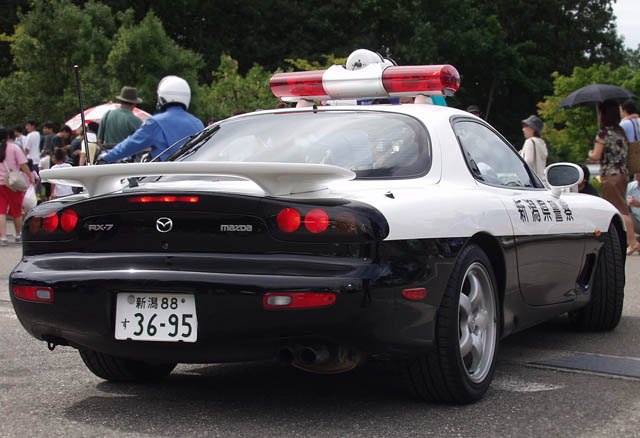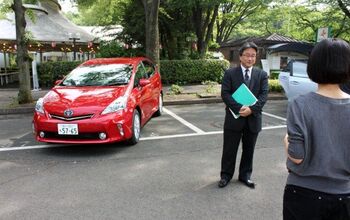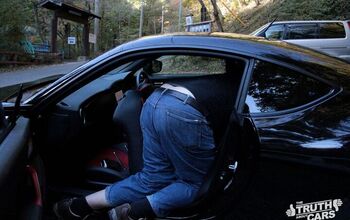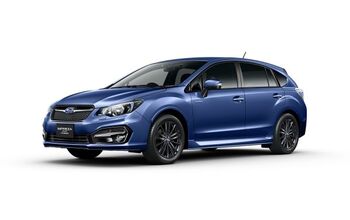: The Cars of the Japanese Police
They can cuff me anytime.
Hot girls in short skirts are the first things that leap into my mind whenever anyone says anything about the Japanese. The internet has not helped to change that, in fact it may have made things worse. If you add the word “Japanese” to any noun that describes a group of people and enter it into your favorite search engine, pictures of hot young girls will always appear near the top of the results. Look for Japanese tour guides, Japanese students, Japanese beach volleyball players or Japanese anything and you will see I am right. Try it, I’ll wait.
Now that you’re back, did you look for Japanese Police? I did, and despite my prior confession I was surprised at what I found.
One of the most respected and professional police forces in the world, the Japanese “keisatsu” is a no nonsense outfit that takes its work seriously. Detectives pour over crime scenes and mark even the smallest bits of evidence with dozens of tiny red flags, rank and file officers patrol the streets on foot in groups or individually man “police boxes” in virtually every neighborhood and Japanese traffic police hone their driving and motorcycle riding skills to such perfection that only an idiot would think about running. The keisatsu is not an organization to be disrespected or trifled with and anyone who does, does so at their own peril.
Like any modern police force, the Japanese police have a tremendous amount of equipment. I could write several articles detailing armored cars, motorcycles, disaster response vehicles, buses, etc. but the most instantly recognizable vehicle in any police force is always the police car and Japan is no exception. Decked out in stunning black-and-white livery, Japanese police cars command instant attention and respect on the street. Unlike the United States, where most police cars are one of just two or three common types of sedan, the Japanese use an astonishing variety of cars, each especially suited to a specific role.
This photo is a bit dated, but I still love it.
Without a doubt, the coolest cars in the Japanese police’s motor pool are the interceptors, and well they should be because they are based on some of the baddest rides going. Some of the more famous examples have been Skyline GTRs, Mitsubishi 3000 GTs (Called the GTO in Japan), the RX-7, RX-8 and even the Fairlady Z. However, the Japanese police seldom engage in high speed chases and the rules of the road are usually maintained by speed cameras and the good old fashioned speed trap. So, while they look glorious wearing their official colors, these cars are used more as public relations tools than they are as true enforcers of public order.
One tool the keisatsu does use to great effect on the road is the unmarked car. These can be virtually any make or model and generally they hide their lights in the grill or under trap doors in the roof that pop open when they are triggered. I imagine that, like the unmarked cars used by American police forces, these cars are easily recognized by the locals but to me they were a real threat. On at least two occasions I ended up having polite conversations at the side of the road after cutting around a line of slow moving cars on the freeway to find one of these at the head of the parade. In both cases I got a firm talking to, but fortunately no tickets.
The Toyota Crown at work – check out those raised lights!
The backbone of the Japanese police fleet is the “patto-ka” and the most common patrol car on the Japanese roads today is the Toyota Crown. I have seen three versions of the Crown in action. One wears police livery but goes without the overhead lights and I presume this type of car is used by high ranking officers as a part of their duties. Actual “siren cars” as every little Japanese boy calls them, come in two flavors, those with regular, fixed red lights and those with red lights that can be raised for better visibility at accident scenes. Toyota Crowns, by the way, are also used in Japan as taxi-cabs and medium sized limos. The sheer number of them on the road makes me think they are pretty tough cars.
The Japanese police car Americans know the least about are those most often assigned to small neighborhood police stations. Because the Japanese police are committed to community policing, officers are often assigned to these small “koban” and they generally stay close to their duty station. The cars attached to these outposts are usually small econoboxes, with the cars most used being from the tiny 660cc kei class. These little cars are a great fit because they work well on narrow roads and offer the ability to carry a passenger. They are by no means fast and they would not serve as good patrol units, but they were never intended to.
A typical around town police car.
That’s because when posted to a Koban, Japanese officers are most often found on foot or on bicycles. Of course, we have bicycle patrols in the United States as well, but unlike the expensive high tech multi-speed bikes that specially outfitted and uniformed police use in our country, the Japanese approach is more mundane and makes a lot more sense.
Decked out in their regular uniforms on the same type of plain, single speed upright bikes often used by Japanese housewives, complete with handlebar mounted baskets and small cases on the cargo racks, the keisatsu are able to see and hear things that they might miss were they to patrol using motorized transport. They use the bicycle to its best advantage and their accessibility to the public makes the cop on the beat an easily approachable and welcome part of any neighborhood. How many American children know the names of the police officers who patrol our neighborhoods?
Bicycles patrols are more than just effective ways to reach the public, the are also environmentally friendly. As the sponsor of the Kyoto Convention on Climate Control, the Japanese government is especially concerned about going green wherever possible and, as a result many of the newest official vehicles are either hybrid or battery powered and police cars are no exception. As with the kei class cars, these vehicles are used in for short trips rather than day long patrols, but the fact they are relied upon at all shows that the Japanese police are constantly looking to modernize their fleet. Like the interceptors, these cars garner a great deal of public attention and often appear at public events. I expect that the numbers of these in service with the police will continue to increase as time goes on.
The Japanese police are a good organization that works hard to ensure public safety. They are serious about the job they do and the variety of vehicles they operate says a lot about their commitment. Like police forces worldwide, the Japanese police must work within a budget and one way they do so effectively is by using the right tools for specific jobs. I hope you have enjoyed this limited look at some of the cars they utilize in their effort to protect and to serve.
The average Japanese cop is more about kicking ass than he is about showing it.
Thomas Kreutzer currently lives in Buffalo, New York with his wife and three children but has spent most of his adult life overseas. He has lived in Japan for 9 years, Jamaica for 2 and spent almost 5 years as a US Merchant Mariner serving primarily in the Pacific. A long time auto and motorcycle enthusiast he has pursued his hobbies whenever possible. He also enjoys writing and public speaking where, according to his wife, his favorite subject is himself.
Another dated photo, but too awesome to pass up.
They can cuff me anytime.
These guys are the real-deal.
The Toyota Crown at work – check out those raised lights!
A kei class van.
A neighborhood “police box.”
A typical police motorpool, including a crash response truck.
Once upon a time, the fast cars of the Japanese Police were imports.
Nissan March – not kei class, but small.
Mitsubishi electric
This photo is a bit dated, but I still love it.
Mazda RX-8
R33 Skyline
A typical unmarked Nissan Skyline
A typical around town police car.
The Fairlady Z
On patrol with the Japanese police.
More by Thomas Kreutzer
Latest Car Reviews
Read moreLatest Product Reviews
Read moreRecent Comments
- Lou_BC Synthetic oil for my diesel is expensive. It calls for Dexos2. I usually keep an eye out for sales and stock up. I can get 2 - 3 oil and filter changes done by my son for what the Chevy dealer charges for one oil change.
- Joe65688619 My last new car was a 2020 Acura RDX. Left it parked in the Florida sun for a few hours with the windows up the first day I had it, and was literally coughing and hacking on the offgassing. No doubt there is a problem here, but are there regs for the makeup of the interiors? The article notes that that "shockingly"...it's only shocking to me if they are not supposed to be there to begin with.
- MaintenanceCosts "GLX" with the 2.slow? I'm confused. I thought that during the Mk3 and Mk4 era "GLX" meant the car had a VR6.
- Dr.Nick What about Infiniti? Some of those cars might be interesting, whereas not much at Nissan interest me other than the Z which is probably big bucks.
- Dave Holzman My '08 Civic (stick, 159k on the clock) is my favorite car that I've ever owned. If I had to choose between the current Civic and Corolla, I'd test drive 'em (with stick), and see how they felt. But I'd be approaching this choice partial to the Civic. I would not want any sort of automatic transmission, or the turbo engine.




















































Comments
Join the conversation
Good read, though I don't agree with your take on the bicycles. Maybe they don't go very far or very fast, but as a regular bicycle commuter I'd consider it a hardship to spend much time on such inefficient and ergonomically poor bicycles, especially while wearing a regular uniform. Our locals cops aren't riding anything terribly expensive. A $600 rigid mountain bike with riser bars and street tires does as good a job as anything.
Most bad ass looking Z car I have ever seen!